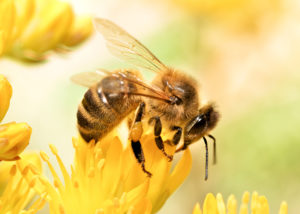 For most people, a bee sting is an uncomfortable experience, but not a life-threatening event. For approximately 3 percent of adults and 0.5 percent of children, however, a sting by a bee, wasp, hornet or yellow jacket can result in a whole-body allergic reaction (anaphylaxis)—a true medical emergency.
For most people, a bee sting is an uncomfortable experience, but not a life-threatening event. For approximately 3 percent of adults and 0.5 percent of children, however, a sting by a bee, wasp, hornet or yellow jacket can result in a whole-body allergic reaction (anaphylaxis)—a true medical emergency.
The best way to prevent an allergic reaction is to avoid being stung. Generally, insects such as bees and wasps aren’t aggressive and only sting in self-defense. If a few bees are flying around you, calmly and slowly walk away from the area—swatting at an insect may cause it to sting. When a bee stings, it releases a chemical that attracts other bees, so if a bee or wasp stings you, or if many insects start to fly around you, cover your mouth and nose and quickly leave the area. Try to get into a building or closed vehicle.
The following are some additional measures you can take to stay sting-free:
- Have hives and nests near your home removed by a professional.
- Use caution when working around bushes, shrubs, trees and trash cans.
- Always wear shoes when walking outside, particularly on grass.
- Wear pants, long-sleeved shirts, gloves, close-toed shoes and socks when working outdoors.
- Avoid very loose-fitting clothing that can trap insects.
- Don’t wear brightly colored clothing or flowery prints because it could attract insects. Avoid using perfumes or other scented products for this reason as well.
- Always check food and drinks (especially open cans of soda or drinks with straws) before consuming, especially at pools and picnics.
- Serve beverages in wide, open cups, since they easily allow you to see what’s inside.
- Avoid eating sweet foods outside.
- Cover food containers and trash cans tightly.
- Clear away garbage, fallen fruit and animal feces (flies can attract wasps).
- Keep the windows rolled up when driving or riding in a car.




